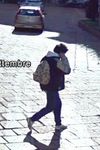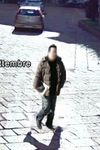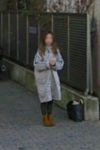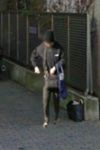Digital Privacy: Replacing Pedestrians from Google Street View Images
←
→
Page content transcription
If your browser does not render page correctly, please read the page content below
Digital Privacy: Replacing Pedestrians from Google Street View Images
Angelo Nodari, Marco Vanetti, Ignazio Gallo
Dipartimento di Scienze Teoriche e Applicate, University of Insubria, Italy
{angelo.nodari,marco.vanetti,ignazio.gallo}@uninsubria.it
Abstract
Given the lack of modern techniques to ensure the
digital privacy of individuals, we want to pave the way
for a new approach to make pedestrians in cityscape
images anonymous. To address these concerns, we
propose an automated method to replace any unknown
pedestrian with another one which is extracted from a (a) Original Image (b) Detection (c) Segmentation
controlled and authorized dataset. The techniques used
up to now to make people anonymous are based mainly
on the blurring of people’s faces, but even so it is pos-
sible to trace the identity of the subject starting from
his clothing, personal items, hairstyle, the place and
time where the photo was taken. The proposed method
aims to make the pedestrians completely anonymous,
and consists of four phases: firstly we identify the area
where the pedestrian is located, we separate the pedes-
trian from the background, we select the most similar (d) Inpainting (e) Replacing (f) Final Result
pedestrian from a controlled dataset and subsequently
Figure 1: Summarization of the steps explained in Sec-
we substitute it. Our case study is Google Street View
tion 2 used to automatically make a pedestrian anony-
because it is one of the online services which suffers
mous within a generic cityscape image.
most from this kind of privacy issues. The experimen-
tal results show how this technique can overcome the
problems of digital privacy with promising results.
which they do not wish to be seen publicly [16]. This
point corresponds to the concept of Informational Pri-
vacy [15] which deals with the fact that a person wants
1. Introduction to be in control of his personal information. Often the
publication of this kind of images becomes a privacy
Nowadays we have access to an increasing amount intrusion which corresponds to a situation in which per-
of multimedia content and for this reason the digital sonal information is collected or disseminated without
privacy is becoming a fundamental phenomenon on the consent of the person involved or represented in it [11].
world stage. First of all Google Inc. with its Street View Google over the years has addressed this issue by blur-
service, has collected from 2007 to now a huge amount ring the people’s faces and removing or modifying pic-
of pictures of the major cities and suburbs of more than tures on request. Besides the fact that not all the faces
37 countries around the world [2], and it seems to be a have been correctly identified, it is easy to trace a per-
growing phenomenon. This process of gathering public son’s identity basing on his clothing, personal items,
images has inevitably collided with privacy issues. Pri- hairstyle, the place and time where the photo was taken.
vacy advocates have objected to these Google services, Consequently, nowadays, we are not yet able to provide
which show men leaving strip clubs, protesters at an a reliable service to ensure the privacy in this type of
abortion clinic, sunbathers in bikinis and in general peo- images.
ple engaging in activities visible from public property in The goal of this study consists in opening the wayto a technique, to the best of our knowledge, not yet erly reconstruct all the scene occluded by a pedestrian.
explored, concerning the anonymization of pedestrians Therefore, in order to reconstruct this information, it
within public images by replacing them with images is possible to use stereo images or multiple view im-
of pedestrians taken from a controlled and authorized ages, but also with this type of images it may occurs
dataset composed of pedestrians in different poses. This unfortunate occlusions that prevent to retrieve the en-
dataset can be constructed artificially or built using peo- tire occluded area. Moreover, using this technique, the
ple who have given their permission for the public usage removal of the shadows that often are on the sidewalk
of their images. For simplicity, in this study we built remains a challenging problem, an example is showed
a dataset composed of pedestrians taken from Google in Figure 4. So even the way of the inpainting suffers of
Street View images. major limitations.
Using the proposed method it is possible to perform
a complete replacement of the pedestrian keeping a life- 2. Proposed Method
like picture and at the same time ensuring a complete
anonymity of the photographed subjects. An example For the aforementioned reasons we propose a new
of the application of this technique is shown in Figure 1. method which is based upon four steps: firstly we use a
In order to make a pedestrian anonymous, the pre- people detection algorithm based on Histogram of Ori-
liminary step consists in its detection. The main used ented Gradients (HOG) [4], in the second step we seg-
techniques were developed for Collision Avoidance ment the pedestrian from the background using a multi-
Systems and Driver Assistance Applications and in re- neural network approach [1], in the third step for each
cent years they are growing very quickly due to indus- segmented pedestrian we find the most similar one in
trial interests [8, 5]. The main approaches are based the dataset of controlled pedestrians and subsequently
on dedicated hardware capable of collecting infrared, we replace it using a set of techniques of Image Mat-
stereo or multiple view images [8]. In this study we de- ting and Composition [18].
cided to work with single 2D images as a case study, We chose the HOG as a feature descriptor because
with the possibility to extend it to other types of im- it is considered the state of the art in pedestrian detec-
ages in the future. The use of 2D images makes the tion and its performance and its computational speed on
detection task very competitive because there is not any our datasets have given very good results, an example is
additional spatial information about where the objects showed in Figure 1b.
are and what their general size is. Instead, for the After have detected the pedestrians, a crucial step
techniques which focus only on the anonymization of consists in the segmentation of the subjects from the
the face it is sufficient to identify the faces within im- background. To perform this step we used our re-
ages [19]. In both cases, once detected the pedestrian or cently published algorithm, called MNOS [1], based
his face, these techniques blur the pedestrian’s face or on a Multi-Neural Networks approach, which has not
remove him completely reconstructing the area that the yet been applied to the segmentation of people, but it
pedestrian had occluded. is highly configurable and is giving very good results.
The blurring of the pedestrians’ face is the main Due to the many poses of the pedestrians, their personal
technique used to make the Google Street View images items which may be of different shapes and the occlu-
anonymous, it is very fast to compute and false positives sions with other pedestrians, this task is considered very
make artifacts that are not too disturbing for the user [7]. difficult. For this reason we have restricted the problem
As we mentioned above, despite the false positives, this considering not crowded scenes and pedestrians carry-
technique does not guarantee a full anonymization, be- ing only small objects like bags or backpacks and not
cause it is possible to trace the identity of a person from for example luggage, bicycles or strollers, cases which
other information. require a deep analysis on the human pose estimation.
A very promising way to make a pedestrian anony- The output of the MNOS is a segmentation mask,
mous, which is showing good results, is the Inpaint- showed in Figure 1c, which we used to perform the in-
ing technique [13], which consist in to remove fore- painting process, Figure 1d. In this way we can subse-
ground objects from a scene replacing their covered quently replace the pedestrian with another one, without
area with an estimation of the surrounding background. worrying about any area which remains uncovered into
This technique was initially created for the restoration the replacement process, because it will be filled with
of pictures and recently has been used for the removal an estimation of the surrounding background by the in-
of pedestrians with interesting results [6, 12]. This tech- painting phase.
nique, however, has severe limitations concerning the Our purpose at this step is to find a pedestrian from
area to be rebuilt and it is sometimes impossible to prop- the controlled dataset, which best overlaps with the(a) Original Image (b) Detection (c) Segmentation
(d) Inpainting (e) Replacing (f) Final Result
Figure 2: A successful pedestrians anonymization in a complex scene using the method proposed in this study. In the
original image (a) the pedestrians are detected and these regions of interest (b) are processed by a segmentation step
(c). This resulting information is used in the inpainting phase in which the pedestrian to replace is removed and the
area compensated with the background (d). Consequently the best overlapping pedestrians are chosen (e) to obtain the
final result (f).
pedestrian to be replaced and at the same time we want ear interpolation using
that it has a similar pose, but not necessarily the same,
because our goal is to fill at the best the area which C = (1 − α)B + αF
was covered by the removed pedestrian. To do that we
used the Chamfer distance [10], which has already been where α is provided by the segmentation algorithm, C
used as a distance between pedestrians images, show- is the final color, B is the background color and F the
ing that it is fast to compute and robust to minor occlu- foreground color. The result of this process is showed
sions. Given E(a, b) the Euclidean distance between in Figure 1f.
two points a, b and two images I and J the Chamfer
Index C is computed as 3. Experiments
X
C(I, J) = E(i, arg min(E(i, j)))
j∈J As additional contribution in this study, we built two
i∈I
datasets used in the experimental phase and uploaded
where i is an edge point in I and j in J. to our homepage in order to be used by future methods
In order to replace a pedestrian with another one, we for comparison 1 . The first one is called Google Street
have to deal with problems of scale, artifacts derived View Scenes (GSVS) and consists of 200 cityscape im-
from the fusion between foreground and background, ages, the second is the Controlled Pedestrians Dictio-
lighting, color balance, etc. To address these issues we nary Dataset (CPDD) consisting of 100 pedestrian im-
used a sampling-based approach of Image Matting [17] ages used for the replacement and we assume, for sim-
which performs well with medium resolution images, plicity, that every pedestrian has given his authorization
as in our study case, to extract a subject from an image. to use his images in public scenes. All the images, from
The MNOS algorithm produces a map that we used as a both the datasets, are taken from Google Street View
Trimap to tune the α value and to estimate the size and and manually segmented.
the position of the replacing pedestrian.
In order to evaluate the performance of the detection
To insert the chosen pedestrian without the introduc-
algorithm, we tested it on the GSVS dataset obtaining
tion of artifacts due to the difference between its back-
the result showed in Table 1.
ground and the background of the replaced pedestrian,
we used a Compositing approach [3]. We applied a lin- 1 http://www.dicom.uninsubria.it/arteLab/We tested the segmentation performance of the
MNOS algorithm using the evaluation metrics pre-
sented in [1] showing the results in Table 1.
We propose a supervised evaluation method in order
to compare shape matching techniques on this partic-
ular problem focused on the overlapping area, from a
quantitative point of view. We ranked the results re-
(a) Original (b) Processed (c) Original (d) Processed
turned by the matching algorithm in according to the
Chamfer distance and to properly evaluate the matching Figure 3: Some lighting errors due to the different light
phase we used a well-know method in Information Re- conditions of the original scene and the scene belonging
trieval called Normalized Discounted Cumulative Gain to the replacing pedestrian.
(nDCG) [9], Equation 2. This is computed from the
Discounted Cumulative Gain (DCG), Equation 1.
p
X 2reli − 1
DCGp = (1)
i=1
log2 (1 + i) ing according to the pedestrian to replace and a regis-
tration on the center of mass of the two pedestrians,
given P the dataset of pedestrian, p is the number overwritten on the scene. We used a sampling-based
of retrieved results to evaluate, i is the rank position of approach to overcome the introduction of artifacts due
a specific pedestrian in the retrieved results, reli is its to the different backgrounds where were being the two
relevance value (in our case reli ∈ {1, |P |} such that pedestrians [18]. To evaluate the replacing step we used
reli = 1 is the least relevant pedestrian and reli = |P | the Jaccard Index reporting the results in Table 1.
is the most relevant one).
The nDDG takes also in consideration the Ideal For each phase we have provided an evaluation
Discounted Cumulative Gain (IDCG) which corre- method and in order to evaluate the overall accuracy of
sponds to the ideal ranking. Given that our goal is to the proposed method we used the Jaccard Index on the
replace a pedestrian with another one that best overlaps, output images of all the steps, we also report the com-
our ideal ranking is in function of the covered area esti- putational time for each step using a single C# thread
mated using the Jaccard Index [14] applied to the truth code, on a Intel R Core TM i5 CPU at 2.30Ghz, these re-
segmentation masks as a measure defining the value be- sults are showed in Table 1.
tween the intersection on the union of two segmenta-
tion areas, in our case the area of the pedestrian that we
A successful example of the whole process in a scene
have to replace and the area of the pedestrian extracted
with many pedestrians is shown in Figure 2. Nonethe-
from the controlled dictionary. An example is showed
less, the experiments show the limits of this application,
in Figure 1e, where the shape of two pedestrians are
which consist in the management of crowded and com-
represented in red and blue and their overlapping area
plex scenes, which can be the starting point for more
in violet.
detailed investigations into the issue presented in this
DCGp study. For example the most noticeable errors are due
nDCGp = (2) to the pedestrians occlusions with the scene, such as a
IDCGp
fire hydrant, a street light, an advertising billboard, etc.
Using the Chamfer distance, the nDCG, whose which can be overcome automatically selecting only
value is in [0, 1] where 1 is the best result, is reported in the appropriate pedestrian parts to be replaced. An un-
Table 1. We used the Chamfer distance, in the matching solved problem consists in managing of light effects and
phase, because it needs only the image and not neces- illumination consistency, in other words, the replacing
sarily the mask, which we used only for the evaluation, pedestrian must be subjected to the same light condi-
whose generation is time consuming, so in a real appli- tions of the replaced one in order to maintain the ap-
cation it is possible to build arbitrarily large datasets. pearance of the scene realistic, artifact that can be no-
The inpainting phase is closely related to the segmenta- ticed in Figure 3. In addition, a last aspect is to replace
tion step and therefore can only be evaluated consider- a pedestrian with another one that has no only a similar
ing the segmentation results. shape, but who is moving also in the same direction, so
After having identified the most similar pedestrian as to avoid paradoxical situations, such as a pedestrian
to the one to be replaced, it is separated from the back- who is walking towards a wall, a street pole or another
ground using the segmentation mask and, after a resiz- pedestrian.Street View: Capturing the World at Street Level. IEEE
Computer, 43:32–38, 2010.
[3] J. F. Blinn. J. Blinn”s Corner: Compositing Part 1: The-
ory. IEEE Computer Graphics and Applications, 1994.
[4] N. Dalal and B. Triggs. Histograms of oriented gra-
dients for human detection. In Computer Vision and
Pattern Recognition, volume 1, pages 886–893, 2005.
(a) Original (b) Processed [5] M. Enzweiler and D. M. Gavrila. Monocular Pedestrian
Detection: Survey and Experiments. IEEE Transactions
Figure 4: An example of the successful management of on Pattern Analysis and Machine Intelligence, 31:2179–
shadows by the proposed method. 2195, 2009.
[6] A. Flores and S. Belongie. Removing pedestrians from
Table 1: ”Segmentation“, ”Matching“ and ”Replacing“ Google street view images. In Computer Vision and Pat-
steps are evaluated on a single pedestrian of the CPDD, tern Recognition, 2010.
”Detection“ and ”All Phases“ on the GSVS composed [7] A. Frome, G. Cheung, A. Abdulkader, M. Zennaro,
by an average of 1.6 pedestrians for each scene. B. Wu, A. Bissacco, H. Adam, H. Neven, and L. Vin-
cent. Large-scale privacy protection in Google Street
View. In International Conference on Computer Vision,
Phase Evaluation Method Result Time
pages 2373–2380, 2009.
Detection F-measure 0.76 5.5s [8] D. Gernimo, A. M. Lpez, A. D. Sappa, and T. Graf. Sur-
Segmentation Single Class Accuracy 0.75 3.8s vey of Pedestrian Detection for Advanced Driver Assis-
Matching nDCG5 0.71 4.2s tance Systems. IEEE Transactions on Pattern Analysis
Replacing Average Jaccard Index 0.68 0.3s and Machine Intelligence, 32:1239–1258, 2010.
All phases Average Jaccard Index 0.47 21.4s [9] K. Jarvelin and J. Kekalainen. Cumulated gain-based
evaluation of ir techniques. ACM Transactions on In-
formation Systems, 20:422–446, 2002.
4. Conclusions [10] I. Katz and H. K. Aghajan. Multiple camera-based
chamfer matching for pedestrian detection. In ICDSC,
pages 1–5, 2008.
In this study we have presented an innovative method
[11] B. Rossler and R. Glasgow. The value of privacy. Polity
to ensure digital privacy in cityscape pictures based on Press: Cambridge, 2004.
the replacement of pedestrians, in particular we worked [12] T. Shibata, A. Iketani, and S. Senda. Fast and structure-
on Google Street View images. The proposed method preserving inpainting based on probabilistic structure
produces a completely anonymous image and at the estimation. In IAPR Conference on Machine Vision Ap-
same time does not present the artifacts, like blurring plications. ACTA Press, 2011.
areas, typical of other techniques used today to man- [13] T. K. Shih and R. C. Chang. Digital inpainting survey
age this privacy issue. As a contribution in this study, and multilayer image inpainting algorithms. In Interna-
we provided two datasets, a baseline for future works tional Conference in IT Application, 2005.
[14] P.-N. Tan, M. Steinbach, and V. Kumar. Introduction to
and an evaluation method to measure the goodness of
Data Mining. Addison Wesley, 2005.
this type of replacing approach. Given the promising [15] H. Tavani. Ethics and Technology: Controversies,
results in this field and the growing interest in digital Questions, and Strategies for Ethical Computing. John
privacy, we are working on the application of this tech- Wiley & Sons, 2010.
nique in images of crowded scenes, occluded pedestri- [16] J. Thornton. Individual privacy rights with respect to
ans, cyclists etc. in order to overcome the constrains of services such as Google Street View. pages 70–76,
the proposed method. 2010.
[17] J. Wang and M. F. Cohen. Image and Video Matting: A
Survey. Foundations and Trends in Computer Graphics
References and Vision, 3:97–175, 2007.
[18] J. Wang and M. F. Cohen. Simultaneous Matting and
[1] S. Albertini, I. Gallo, M. Vanetti, and A. Nodari. Learn- Compositing. In Computer Vision and Pattern Recogni-
ing object segmentation using a multi network segment tion, 2007.
classification approach. In International Conference on [19] C. Zhang and Z. Zhang. A survey of recent advances in
Computer Vision Theory and Applications, 2012. face detection, 2010.
[2] D. Anguelov, C. Dulong, D. Filip, C. Frueh, S. Lafon,
R. Lyon, A. S. Ogale, L. Vincent, and J. Weaver. GoogleYou can also read



























































